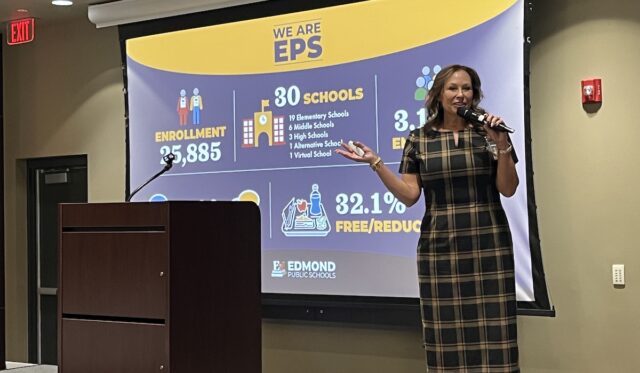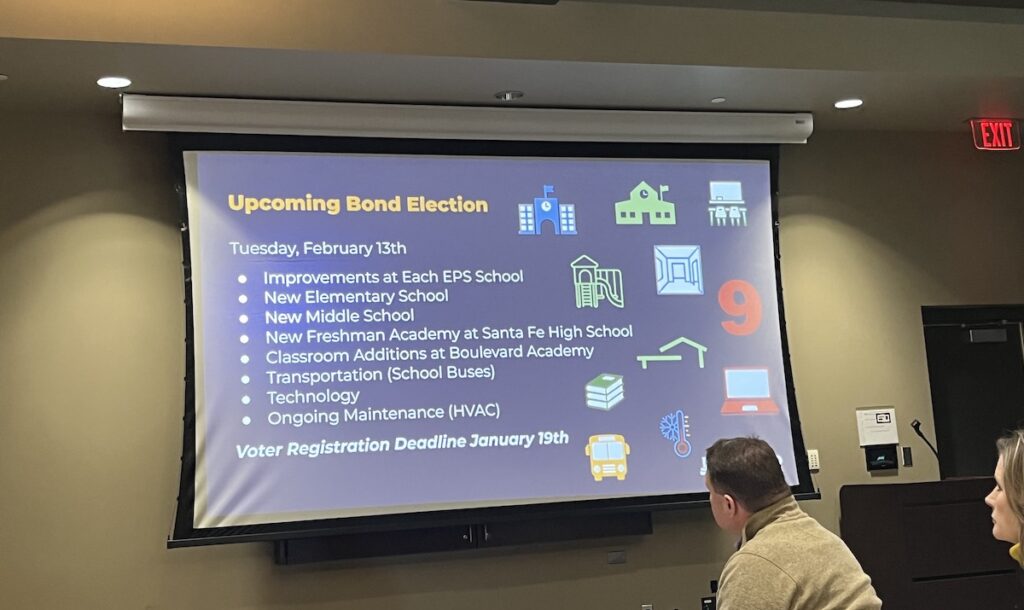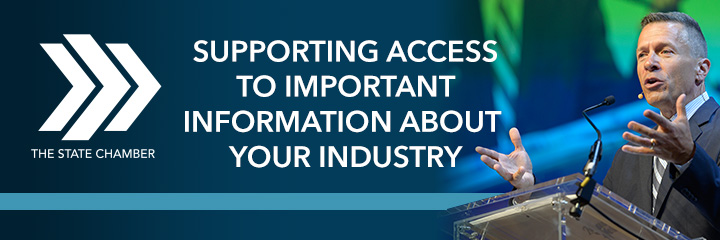
At the district’s State of the Schools luncheon this afternoon, Edmond Public Schools Superintendent Angela Grunewald discussed details of a planned Feb. 13 bond election and announced a free, dual-enrollment program that targets first-generation and underrepresented students.
Grunewald began her portion of the presentation by addressing the fluctuating enrollment numbers that the district has experienced since the COVID-19 pandemic three years ago.
“If I could show you the graph of Edmond Public Schools enrollment over the past 20 years, you would see this just beautiful, very predictable line, that every year our enrollment went up 200 to 400 students,” Grunewald said.
Grunewald said enrollment decreased when the COVID-19 pandemic struck, before rebounding the following year.
“Last year, we grew by 705 students, and we were kind of nervous,” Grunewald said. “Are we going to grow by 700 students every year, and is that even going to be sustainable for us?”
However, the district’s enrollment pendulum swung the opposite direction this year, Grunewald said.
“We could not wait until our enrollment started coming in this year to find out what is our new norm, and what I’ve decided is we don’t have a new norm, because then we dropped this year — almost 200 students,” Grunewald said. “So, we’re still just seeing this incredible fluctuation in our enrollment.”
While enrollment is decreasing in some areas, it’s growing in east Edmond, Grunewald said.
“If you’re worried about that, we are still growing over there and still have some overcrowded schools in different places, but overall enrollment is down,” she said.
Grunewald also noted that 32 percent of students in EPS are receiving free and reduced meals, an increase from the numbers the district recorded prior to the pandemic.
“We were holding in that 24 to 26 percent free and reduced (lunch) for years,” Grunewald said.
For two years during the COVID-19 pandemic, a federal program allowed all public school students to eat for free in their cafeterias rather than offering it only to children living in poverty or students in low-income areas. During that time, the district did not record the number of students receiving those meals.
“This year, meals are no longer free, so everyone that qualifies is filling out the form, and our percentage has jumped to 32 percent,” Grunewald said. “We don’t know if that was a gradual incline, because we had some years where we didn’t get the information, or if we just made that drastic jump. That is almost a third of our students (who) live in poverty.”
That percentage is not distributed equally across each school, Grunewald said, adding that some EPS schools’ poverty rates are as high as 80 percent.
“That means almost every student in that school lives in poverty,” Grunewald said. “It’s a different picture than what people think of when they think of Edmond Public Schools and what our student body looks like.”
After the event, Edmond Mayor Darrell Davis said the number of students receiving free and reduced lunch is “a reflection of our community.”
“We have people that can afford to eat, and we have people that can’t afford to eat,” Davis said. “It’s fortunate that we have a school system that is looking out for those students, because we all know that for them to learn at the highest level, they have to have some food in their stomach.”
New east Edmond elementary school, middle school proposed

Grunewald later discussed items that are planned to be on the Feb. 13 bond election but clarified that the details are yet to be finalized. The EPS Board is expected to call for a resolution setting the election date and proposals next month, Grunewald said. Requiring 60 percent voter approval under state law, school bond elections allow a district to take out loans to finance capital projects, including building and upgrading schools and buying busses and technology.
Grunewald said the Feb. 13 bond election will propose funding for improving infrastructure elements like heating and air conditioning for all elementary schools, but she said the election will also include bond funds for a new elementary school and a new middle school on the east side of the district.
The city and the district alike have planned for growth in east Edmond. EPS paid $3 million to acquire 80 acres of property at Air Depot Boulevard and Covell Road in May 2013 for an elementary school and middle school. Additionally, the district paid $2.8 million for 80 acres at the intersection of Westminster Road and Covell Road in May 2022 for the construction of a fourth high school.
Grunewald said Redbud Elementary School, which opened in August 2021 in Arcadia, is already at full capacity.
“We keep building these new elementary schools,” she said. “You know what that eventually means: You’re going to need a middle school.”
Grunewald said she is unsure when the east high school will be built but that the need is there.
“If you keep building more elementary and more middle schools, they grow up. You can’t stop that from happening,” she said.
A new freshman academy at Santa Fe High School is also a planned item for February’s bond election. Grunewald said the addition of a new high school in east Edmond will not lessen Santa Fe High School’s growing enrollment, as it only serves students to its west.
In 2024, Edmond residents could also be asked to approve a bond election that could be called by the city for road improvement and quality-of-life projects. Edmond officials have floated the idea and recently held a joint discussion with EPS board members and staff regarding the impact of both entities calling for bond elections.
New college readiness program launching at EPS
Edmond Public Schools will be introducing a free, dual-enrollment program that will allow students to graduate from high school with an associate degree from the University of Central Oklahoma, Grunewald announced at the luncheon.
Grunewald said the partnership with UCO is funded by the Edmond Public Schools Foundation, to which she encouraged attendees to donate.
“We’re going to start out with 30 students. They will be students from either poverty or first (students) in their family to attend college,” Grunewald explained. “They will start out as freshmen as a cohort, and they will move through and take classes together their freshman year about what it means to be college ready.”
Students in the program will then begin taking concurrent classes in their sophomore year and will likely spend the majority of their senior year on UCO’s campus, Grunewald said.
“But when they graduate from high school, they will have an associate’s degree from UCO,” Grunewald said. “It may be that this is where they join the workforce, but they joined the workforce better prepared and better educated.”
Sherry Jordan, the president and CEO of the Edmond Chamber of Commerce, praised the new program.
“I think it’s really exciting, because now when a student goes concurrent, they don’t get a credit in both places. They only get the credit at UCO, and they have to pay the fees, so only their tuition is covered,” Jordan said.
Jordan noted the importance of introducing first-generation college students to the university environment.
“It’s so important to help give them a leg up and help them understand what college is all about,” Jordan said. “And whether they continue on after the associate’s or not, at least they have that to take into the workforce with them.”
Keylon talks enrollment, programs at Francis Tuttle
Francis Tuttle Technology Center Superintendent Michelle Keylon made the first presentation at Monday’s EPS State of the Schools event by sharing that the career-training school is at 91 percent capacity and that the placement rate from Francis Tuttle’s 2022 classes has almost reached 93 percent, meaning graduates are landing jobs.
However, she also noted that enrollment waiting lists for high school students and adult students have grown.
“We were able to get everyone in except for about 200 high school students, and then for our adult wait lists (…) we are now at 600 students,” she said.
Keylon said the school has closed applications for several programs owing to the wait lists.
“Three cosmetology programs, two esthetician, two nails, our day and evening culinary program and our two welding programs — we’re no longer taking applications for this school year because we have so many on the wait list,” Keylon said.
Keylon said that Francis Tuttle is working to open up more sections to accommodate those students.
“They’re coming faster than we have room for them right now,” Keylon said.
She said Francis Tuttle also added offerings this year: A new welding program, an evening construction trades program, an additional 2D-animation program, and additional nursing and pre-nursing programs.
Next year, Francis Tuttle is set to add a “teacher prep” program, she said.
“Hopefully we can fill some of those slots in the future teachers that we don’t have. I know everybody’s working on this. I know Edmond’s working on it. We’re partnering with UCO as well to try to get that pipeline to them,” Keylon said. “I just don’t think enough groups can work on this, because we just need really great teachers for our future generations.”
Sen. Adam Pugh (R-Edmond), who attended the EPS State of the Schools event, said Oklahoma’s education system needs to be focused on preparing students for the workforce.
“We have to think of them as linked. We have to think of education as the process and the system that produces the workforce,” Pugh said. “So, I love when I hear school leaders thinking in comprehensive terms that way, and not only thinking that way, but now having plans and programs that are actually going to feed that workforce because we know from just talking to businesses, that’s the biggest issue that’s going on in the state.”





















